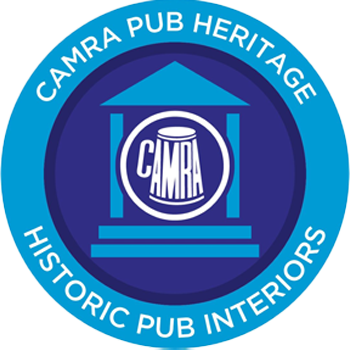This website is currently in beta. If you wish to go back to the current site please click here. To provide feedback or find out more about this site, please click here.


1930s pub, built in "brewers' tudor" style, as part of a shopping parade. Notable for still being divided into separate rooms - public bar, saloon bar and games room. The interior features include vine-pattern cornices, fielded wood panelling, panelled bar-backs and counters. Sadly the pub no longer sells real ale and the handpumps are disused.
Three star - A pub interior of outstanding national historic importance
Listed status: II
A 1930s estate pub which has kept a good deal of its original plan, fittings and character. It is in the popular ‘brewers’ Tudor’ style with imitation half-timbering above and buff faïence cladding below. On the far left is a former off-sales shop, now disused of course. Then comes the public bar which, like the rest of the pub, has three-quarter-height wall panelling. The vine decoration in the cornices is also repeated throughout. Beyond the main public bar is a smaller extension and the remnants of a sliding screen that would have separated the two (the rear part has a sash window to the servery). The screen on the right of the public bar has a low service doorway to what was a snug. This has now been amalgamated with the saloon. Further right still is a still extant sliding screen to the large rear room. The counter and back fittings are original as is the high, pink terrazzo spittoon trough which still stands in front of the counter.
Built c.1937 say locals (1929 says Pubology) possibly by Courage, this estate pub has kept a great deal of its original plan, fittings and character. It is in the popular ‘brewers’ Tudor’ style with imitation half-timbering above and buff faïence cladding below. On the far left is a former off-sales shop, now occupied by a floral designs business. The rear lounge bar / function room is in a single-storey part of the building.
On the left is the public bar which was two rooms and you can easily see where the partition separating them was as the upper section remains - it could be that what has been removed is a folding screen (one survives in the right hand bar). The room has three-quarter height panelling and a decorative plaster frieze with depictions of hops, flowers and ancathas leaves. The original bar counter remains with an orange terrazzo trough around the base, panelled front and original top. The bar back is a series of leaded glass panels with some wooden shelves and a cupboard with panelled front instead of lower shelving. In the rear section there is a leaded glass counter screen in the closed position, also an original bar counter with an orange terrazzo trough around the base, panelled front and original top; an original wood surround fireplace blocked-up also survies. On the wall between the left hand bar and the middle bar there is a low service door. The ladies’ here has original wall and floor tiles. Gents’ has original urinals, wall and floor tiles.
Middle bar was originally two rooms – on the left was a small snug and then a saloon bar – and you can easily see where the partition separating it was as the upper section remains. The original bar counter remains with an orange terrazzo trough around the base, panelled front and original top. The bar back is of fielded panelling with just a piece of wood for optics added. In the lower section one part is a cool shelf and fridges have replaced half of the remaining shelving. There is an original tiled and wood surround fireplace with a new stove at the right hand end near the folding screen. The room has three-quarter height panelling and a decorative plaster frieze with depictions of hops, flowers and ancathas leaves. Behind the servery there remains the original publican’s office that is still in daily use.
Folding doors separate the middle bar from the rear lounge bar / function room – most parts are in the open position for most of the time with just the right-hand section in the closed position. However, for functions the folding doors are completely closed. The original bar counter remains with an orange terrazzo trough around the base, panelled front and original top. The bar back is of fielded panelling with just a piece of wood for optics added. In the lower section one part is a cool shelf and lots of original shelves remain with only one fridge. The room has three-quarter height panelling and a decorative plaster frieze with depictions of hops, flowers and ancathas leaves. A stage has been added and the wall panelling around it is missing. The gents here has access from both the rear and middle bars, retains original doors, original floor and wall tiling in both the ante rooms and gents’ itself (a lot of wall tiling has been painted over in a light blue colour) and large original urinals. Fixed seating throughout is modern.
Admiral Vernon, Dagenham